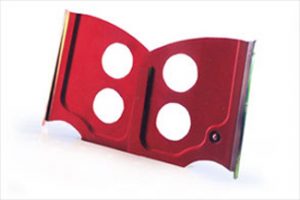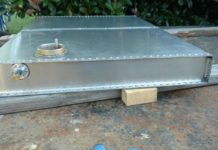This tip was submitted by Ted Beck
History
In 1990 while attending Oshkosh I made a deal with the people in the Precise Flight (PF) booth to go home and develop a method of getting a spoiler box to fit in the Glasair wing. I left Oshkosh, excited about the prospect. At that time I was flying my Glasair I RG and building my III. The wing was still open on the III so I had the perfect place to start. Using the measurements that I got from PF, I made a block of wood that was exactly the same size as the spoiler box. Taking this to the open wing, it wasn’t long until I had proved to myself that I could get the box to fit in the wing without modification.

My plan was to place the box just aft of the main spar, not into the area where the spar bonds to the top and bottom of the wing, and equal distance between the outboard of the elevator and inboard of the aileron. To do this the box would fit, but would be even better if it were one-half inch shorter in height. There was unused space in the bottom of the spoiler box that would allow the elimination of that much height in the cartridge.
The next task was to determine how I could get into the wing of my RG and retrofit a set of spoilers to a flying airplane. Using the directions for the retrofit of an auto pilot roll servo as printed by Stoddard-Hamilton, I came up with my plan of how to get the spoiler into the closed wing.
Other than the III builders, no one at that time was putting fuel behind the spar so I did not have to contend with violating a fuel bay compartment.
I then called PF and sent them some pictures to demonstrate to them that it would work. They in turn sent me a set of plates that I could tape on to the top surface of my wing that would simulate the deployment of the spoilers. I must admit it took a little hangar flying to get up the nerve to fly with a couple of hunks of tin speed taped onto the top of my wings and assume I had enough elevator to fly. If the tape gave way and I lost one of them, would I have enough aileron to handle the roll?
Well, needless to say the tape held, the plane flew and I’m still here.
Helena is at 3900 feet and on a summer day, you may want to take a look at the density altitude. On a cool morning I made two flights a couple of feet above the runway down the 9000 feet. Extra speed (10 kt) was required to fly and the nose did not want to come off the runway without using a lot of elevator. Once airborne, with 20 degrees of flaps, the plane had the ability to accelerate and to climb.
The plane seemed stable in all axis and I had plenty of aileron.
The big question was what if I lost one of them. More speed tape was applied. With no less than a half roll of tape on each wing I was ready to go fly. Take off was uneventful. The plane climbed well considering the loss of lift and the drag created. A trip around the pattern and a landing with a higher than normal angle of attack was attention getting.
The second flight was made the next day. This time out to the practice area. Five hundred foot climbs were made with descents at different speeds/power settings to determine worth of having the spoilers. Three flight total that day were made to get some data for PF. At that point testing was topped and it was time to put the spoiler cartridges in the wing.
PF sent me a set of spoilers and I installed them in my RG.
Installation was not easy but fairly straight forward. The first electric motor sent was placed in the pilot seat pan with little room to spare. It was a bit heavy in my opinion.
The next hurtle to over come was negative flight where the spoilers would come out without warning in turbulence or negative “G” maneuvers. PF designed a little down lock but we soon found that the lock design was very touchy and had to be in exact adjustment.
I think you can see where all of this was going. With a few more tries, both PF and I were starting to understand the difficultly developing the right design. By the time I got my III flying in February of ’92 it was felt by both parties that we had the bugs ironed out.
With the higher speeds and the wing loading of the III, it wasn’t long till we realized that there was so much lift being created over the spoiler that the blades would tend to float above 175 kt. The “G” lock down worked fine initially but if the spoiler was deployed above 175 kt, then it would not return to the locked down position, but float.
The amount of float was based on speed. At 175 knots, the spoiler would show about one half inch of blade. At 200 kt. you would see about two inches of blade. As the pressure varied the blade would bounce up and down. Each blade had its own variation so some asymmetry was present. If one pulled a couple of negative “G’s” you could lock them back down in the box but this was too cumbersome. At Oshkosh this last year PF and I talked it through and right after the fly-in I went out to their factory in Oregon and they completely redid the spoilers. New boxes replaced the old ones with different tension on the blades that took care of the float. A new ball detent was used that is much better than the old lock down. A new motor has been developed that is lighter and a real improvement over the old motor.
Actuation
Your choice is electric or manual.
If you chose electric, there is a dandy little motor that fits under the pilot seat pan between the aileron and flap torque tubes, just left of center to avoid the elevator travel. If there is an electrical failure, the spoilers are spring loaded to close. You can open them any amount you want and can reverse directions at anytime.
Placement
Placement of the plates on the wing and then the spoilers in my RG was purely a guesstimate, but as it turned out, I found them to be well placed and elected to use the same position on my III. The III has a fuel bay right there so I built a box around the spoiler cartridge with the front side of that box, the aileron torque tube tunnel. The cable that controls the spoiler runs down the torque tube tunnel, makes a 180 degree turn on a double pulley block and with the offset created goes into the speed brake box from the outboard side. The box is located 53 inches inboard of the wing joggle for the wing tip and is right behind the main spar layup.
One large objection to the spoilers in this position is the violation of the upper wing surface integrity. I have found that to not be a problem with the way that I chose to lay up the box on the underside of the upper wing panel.
It is my opinion that the wing is stronger. Each builder will have to make that decision for themselves of whether they want to cut a hole in the top of their wing.
Flight
I have deployed the spoilers up to 250 kt IAS without a problem. I have also simulated a failure on one side and believe me, at 250 kt, there is excellent roll rate. There is more than enough aileron to control the bird and at slower speeds, there is less and less effect with the asymmetry. I found the elevator to have plenty of authority in all phases of flight. As it turns out there is little or no pitch changes with their deployment. There is a bit of rumbling when they are deployed and you can tell the airframe in general has a different feel.
As you can see, by looking at the numbers, you can come down like a rock if you want to. If the air is smooth I routinely descend at 200 kt with a two or three inch reduction in power if I am in a hurry and no power reduction if I want to get down but have some time. What really works nice is you enter a downwind at mid
field, pop out the spoilers and go from 200 to 120 kt. IAS by the time it’s time to extend the gear and start you base. On an ILS final you can extend the spoilers, get your gear down and start on glide slope with little forethought to slowing down.
Without spoilers you better have a good plan for how to slow down to configure. In most cases you have to leave the FAP with the gear down or go to idle to slow down.
I normally do not try to adjust my final with the spoilers but it is certainly permissible. I always extend them on touchdown. The bird stops flying and it takes away all that tendency to float if you’re a little hot. Nothing replaces an on airspeed landing, but the spoilers will glue you on and shorten your roll out. It is very important to remember that the Glasair is not very forgiving if you get slow with approach angles of attack. With spoilers the plane can really sink on you.
When flaps are used as drag devices as well as for lift, when you retract them you may get rid of the drag but you also lose lift. With spoilers when you retract them you get rid of drag and increase lift. On a go around the lift and drag are both working for you with spoiler retraction.
 In conclusion, I feel the Precise Flight Spoilers are the best answer I know of for a good descent rate without a large power reduction and as a method of helping the pilot configure prior to landing.
In conclusion, I feel the Precise Flight Spoilers are the best answer I know of for a good descent rate without a large power reduction and as a method of helping the pilot configure prior to landing.
You haven’t spent all the time and money it takes to have a nice Glasair, if you aren’t one of those people who isn’t looking for one more “toy.” Nothing replaces safe airmanship and being a good “stick.” With confidence, I can now tell all Glasair owners and builders that the Precise Flight Spoilers are well worth the effort.



